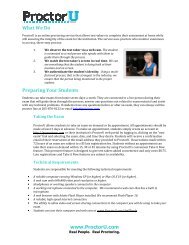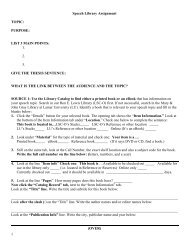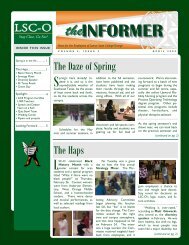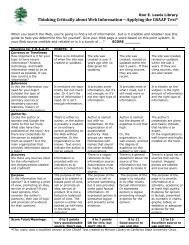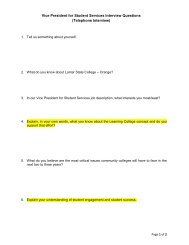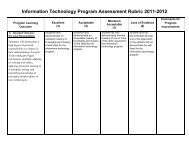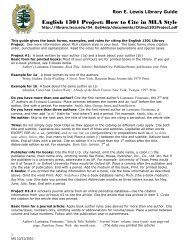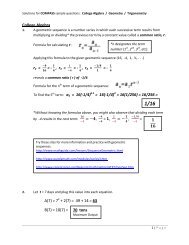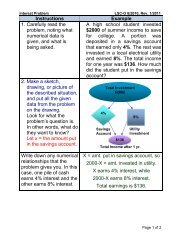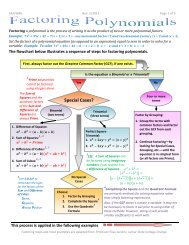Citing the Project in MLA Style - Library
Citing the Project in MLA Style - Library
Citing the Project in MLA Style - Library
Create successful ePaper yourself
Turn your PDF publications into a flip-book with our unique Google optimized e-Paper software.
Ron E. Lewis <strong>Library</strong> Guide<br />
How to Cite: English 1301 <strong>Project</strong> <strong>in</strong> <strong>MLA</strong> <strong>Style</strong><br />
http://library.lsco.edu/Help/<strong>Cit<strong>in</strong>g</strong>1301<strong>Project</strong>.pdf<br />
This guide provides basic <strong>MLA</strong> formats with examples, and rules for cit<strong>in</strong>g items for <strong>the</strong><br />
English 1301 <strong>Library</strong> <strong>Project</strong>. See more <strong>in</strong>formation about <strong>MLA</strong> citation style <strong>in</strong> your text. The<br />
basic formats show order of each part (i.e. author, title, publisher city & name, year or o<strong>the</strong>r source<br />
<strong>in</strong>fo such as database name, medium, date of access). Follow rules as to punctuation, capitaliz<strong>in</strong>g and<br />
italiciz<strong>in</strong>g of <strong>the</strong> parts.<br />
<strong>Project</strong> #1-2: A book written by your author (#1) and a book about your author’s life or works (#2)<br />
Basic form for pr<strong>in</strong>ted books: Most catalog records will be for pr<strong>in</strong>ted books that are <strong>in</strong> <strong>the</strong> <strong>Library</strong>.<br />
If you chose an e-book, an e-book example is shown for #2.<br />
Author’s Lastname, Firstname. Book Title: Subtitle. PublisherCity: PublisherName, publication year. Pr<strong>in</strong>t.<br />
Example for #1: A book written by our example author, Stephen K<strong>in</strong>g.<br />
K<strong>in</strong>g, Stephen. Full Dark, No Stars. New York: Scribner, 2010. Pr<strong>in</strong>t.<br />
Example for #2: A book about Stephen K<strong>in</strong>g and his work. This example shows an e-book with a<br />
title and subtitle. E-books found <strong>in</strong> our <strong>Library</strong> Catalog are <strong>in</strong> <strong>the</strong> database eBooks on EBSCOhost.<br />
Russell, Sharon A. Revisit<strong>in</strong>g Stephen K<strong>in</strong>g: A Critical Companion. Westport: Greenwood, 2002. eBooks on<br />
EBSCOhost. Web. 25 Aug. 2012.<br />
E-book rules: Cite <strong>the</strong> book <strong>in</strong>formation exactly as described for a pr<strong>in</strong>ted book, omitt<strong>in</strong>g <strong>the</strong> word<br />
“Pr<strong>in</strong>t” at <strong>the</strong> end and add<strong>in</strong>g: eBooks on EBSCOhost. (our e-book database) Web. (<strong>the</strong> e-book medium)<br />
day Mon. year. (date of access, when you used <strong>the</strong> e-book) End with a period.<br />
Dates: Cite all <strong>MLA</strong> dates as day Month year without a comma. Abbreviate all months as three letters<br />
except for May, June, July, and Sept. For example: 25 Aug. 2011. Or 8 Sept. 2011<br />
Author variations: More than one author? Cite <strong>the</strong> first named author’s Lastname, Firstname, <strong>the</strong> 2 nd<br />
and 3 rd authors as Firstname Lastname. Place commas between <strong>the</strong> names and <strong>the</strong> word “and” before <strong>the</strong><br />
last author. End with a period. Example: Smith, John, George Jones, and Sam Brown. More than three<br />
authors? Cite <strong>the</strong> first named author as Lastname, Firstname, a comma, and <strong>the</strong>n add “et al.” (lat<strong>in</strong> for<br />
“and o<strong>the</strong>rs”) End with a period. Example: Smith, John, et al. No author? Skip to <strong>the</strong> next part, <strong>the</strong><br />
book’s title. But you probably have at least one author <strong>in</strong> <strong>the</strong> <strong>Project</strong> records. Editor as <strong>the</strong> author?<br />
Cite an editor <strong>the</strong> same as an author but add comma ed. after <strong>the</strong> name: Smith, John, ed.<br />
Titles: Do not simply copy/paste book titles as <strong>the</strong>y appear <strong>in</strong> <strong>the</strong> catalog! Catalog<br />
capitalization rules are not <strong>MLA</strong>! Cite both title and subtitle separated by a colon (:). Capitalize <strong>the</strong><br />
first word of title and subtitle. Capitalize all o<strong>the</strong>r words EXCEPT <strong>the</strong>, a, an, (articles) and, or, not, but, yet<br />
(conjunctions) and words such as of, to, from, near, above, below, etc. (all prepositions). Italicize book<br />
titles. End titles with a period.<br />
Editions: Cite <strong>the</strong> edition of a book after <strong>the</strong> title if it is NOT <strong>the</strong> 1 st edition. Abbreviate edition as ed.<br />
Example: The Title of <strong>the</strong> Book: The Subtitle of <strong>the</strong> Book. 2 nd ed. Edition statements are under <strong>the</strong> title l<strong>in</strong>e <strong>in</strong><br />
catalog records. First editions do not usually have edition statements <strong>in</strong> <strong>the</strong> catalog.<br />
Publisher <strong>in</strong>fo: Cite <strong>the</strong> first city named, omitt<strong>in</strong>g state names, a colon (:) <strong>the</strong> publisher name, ma<strong>in</strong><br />
name only, omitt<strong>in</strong>g non-essential words like Press, House, Publisher, Inc. However, a university press<br />
is abbreviated as UP. For example: University of Texas Press would be U of Texas P and Oxford<br />
University Press would be Oxford UP. Place a comma after <strong>the</strong> publisher name and cite <strong>the</strong> year of<br />
publication. End with a period.<br />
Medium: End book citations with <strong>the</strong> medium: Pr<strong>in</strong>t. (pr<strong>in</strong>ted books) or Web. See e-book example.<br />
1<br />
MG 1/18/2013
<strong>Project</strong> #3: A journal article from an onl<strong>in</strong>e periodical database. Cite that article (#3) as a journal<br />
article from a database.<br />
All types of Article Authors: Apply <strong>the</strong> same author rules as above under books, for one to three<br />
authors, more than three authors, etc.<br />
All types of Article Titles: Cite both title and subtitle separated by a colon (:). Apply <strong>the</strong> same<br />
capitalization rules as for books. Place article titles <strong>in</strong>side “Double Quotes.” And do NOT italicize article<br />
titles. However, if <strong>the</strong> title conta<strong>in</strong>s <strong>the</strong> title of a longer work, i.e. a novel or o<strong>the</strong>r book, italicize that<br />
title only. If <strong>the</strong> title conta<strong>in</strong>s <strong>the</strong> title of a shorter work, i.e. a story, poem or play, put ‘S<strong>in</strong>gle Quotes’<br />
around that title only. End article titles with a period placed <strong>in</strong>side <strong>the</strong> end<strong>in</strong>g quotes.<br />
Journal Source Information: Cite <strong>the</strong> journal name <strong>in</strong> Italics. Cite volume and issue, <strong>the</strong> numbers<br />
only, omitt<strong>in</strong>g words or abbreviations for volume and issue. Place a period between volume and issue<br />
numbers. Follow with <strong>the</strong> publication year <strong>in</strong> paren<strong>the</strong>ses, a colon (:) <strong>the</strong>n page range numbers, <strong>the</strong><br />
start and end pages. For example, Volume 25 Issue 6 for this year would be: 25.6 (2013): 235-45.<br />
Page numbers: For page numbers greater than 99, omit <strong>the</strong> hundreds place number for <strong>the</strong> end<strong>in</strong>g<br />
page, unless it goes <strong>in</strong>to <strong>the</strong> next hundred number: 235-45 (for 245) or 295-305. Cite numbers only.<br />
Do not add “page” or page abbreviations p., pp., pgs., etc. for page numbers.<br />
End with: Database Name <strong>in</strong> italics, Web. date of access as day Mon. year. End with a period.<br />
Basic format for a journal article:<br />
Author’s Lastname, Firstname. “Article Title: Subtitle.” Journal Name volume number.issue number (year):<br />
start page-end page. Database Name. Web. day Mon. year.<br />
Example for #3: A scholarly journal article from Academic Search Complete database:<br />
Janicker, Rebecca. “It’s My House, Isn’t It?: Memory, Haunt<strong>in</strong>g and Lim<strong>in</strong>ality <strong>in</strong> Stephen K<strong>in</strong>g’s ‘Bag<br />
of Bones.’” European Journal of American Culture 29.3 (2010):183-95. Academic Search<br />
Complete. Web. 25 Aug. 2012.<br />
<strong>Project</strong> #4-5 Article from a newspaper (#4) and a news magaz<strong>in</strong>e (#5) us<strong>in</strong>g a database.<br />
Authors: Same rules as for books. Article titles: Same rules as for journal article titles. In Oppos<strong>in</strong>g<br />
Viewpo<strong>in</strong>ts database, phrases added after an article title [<strong>in</strong>side square brackets] are not part of <strong>the</strong><br />
title but are normally various head<strong>in</strong>gs from <strong>the</strong> pr<strong>in</strong>t page (such as Editorial Desk, etc.). Do not cite.<br />
Newspaper and Magaz<strong>in</strong>e Source Information: Omit “The” if it starts <strong>the</strong> name of a newspaper or<br />
magaz<strong>in</strong>e. For city newspapers without <strong>the</strong> city name appear<strong>in</strong>g <strong>in</strong> <strong>the</strong> title, cite <strong>the</strong> city <strong>in</strong><br />
paren<strong>the</strong>ses. Newspapers that are national <strong>in</strong> scope do not need a city. Examples: American Press<br />
(Lake Charles), USA Today, Wall Street Journal. City names are provided <strong>in</strong> Oppos<strong>in</strong>g Viewpo<strong>in</strong>ts.<br />
O<strong>the</strong>r source <strong>in</strong>fo: Instead of cit<strong>in</strong>g volume and issue numbers as we did for journals, cite <strong>the</strong><br />
publication date <strong>in</strong> <strong>MLA</strong> date format: day Mon. year colon (:) page numbers. If you see a letter and a<br />
number for newspaper articles, it is <strong>the</strong> section and page of <strong>the</strong> paper: A1, B2, etc. If you do not see<br />
page numbers use n. pag. (for no pages). If you see an (L) after a page number, it means late edition<br />
of <strong>the</strong> paper, and should be cited after <strong>the</strong> date as: day Mon. year, late ed.: page. We normally see<br />
late editions for <strong>the</strong> New York Times, but <strong>the</strong>re may be o<strong>the</strong>rs.<br />
Basic format for #4 and #5: Articles from a newspaper and a news magaz<strong>in</strong>e<br />
Author’s Lastname, Firstname. “Title: Subtitle of <strong>the</strong> Article.” Name of Newspaper/ Newsmagaz<strong>in</strong>e day Mon.<br />
year: section letter & page number or start page-end page. Database Name. Web. day Mon. year.<br />
Example #4: Both articles <strong>in</strong> Oppos<strong>in</strong>g Viewpo<strong>in</strong>ts <strong>in</strong> Context (<strong>the</strong> topic was “Offshore Drill<strong>in</strong>g”)<br />
Guar<strong>in</strong>o, Mark. “Is Oil Leak<strong>in</strong>g <strong>in</strong> <strong>the</strong> Gulf from <strong>the</strong> BP Spill Site?” Christian Science Monitor 1 Sept.<br />
2011: n. pag. Oppos<strong>in</strong>g Viewpo<strong>in</strong>ts <strong>in</strong> Context. Web. 8 Sept. 2012.<br />
Example #5:<br />
Boyden, Joseph. “Spill<strong>in</strong>g Over: It’s Been a Year S<strong>in</strong>ce <strong>the</strong> BP Disaster, and Nobody Has Learned a<br />
Lesson.” Maclean's 9 May 2011: 34+. Oppos<strong>in</strong>g Viewpo<strong>in</strong>ts <strong>in</strong> Context. Web. 8 Sept. 2012.<br />
2
<strong>Project</strong> #6 Formatt<strong>in</strong>g <strong>the</strong> <strong>MLA</strong> citation page:<br />
• Use <strong>the</strong> assignment header required by your <strong>in</strong>structor.<br />
• Use <strong>the</strong> Times New Roman font <strong>in</strong> 12-pt., recommended for <strong>MLA</strong> style papers.<br />
• Set your page marg<strong>in</strong>s at <strong>the</strong> standard 1 <strong>in</strong>ch all around and double space <strong>the</strong> entire list.<br />
(Our guide examples were not double spaced to save space.)<br />
• Center <strong>the</strong> standard <strong>MLA</strong> citation list title at <strong>the</strong> top, which is: Works Cited<br />
• Use <strong>the</strong> hang<strong>in</strong>g <strong>in</strong>dent format for each citation: <strong>the</strong> first l<strong>in</strong>e is at <strong>the</strong> left marg<strong>in</strong>, and <strong>the</strong><br />
follow<strong>in</strong>g l<strong>in</strong>es are <strong>in</strong>dented ½ <strong>in</strong>ch. Us<strong>in</strong>g MSWord, first highlight your citation and open <strong>the</strong><br />
Paragraph Menu. Under “Indentation,” under “Special” highlight “Hang<strong>in</strong>g” and click OK.<br />
• Item Number<strong>in</strong>g: Number each citation with its correspond<strong>in</strong>g project number. Hit “Enter”<br />
after <strong>the</strong> number to beg<strong>in</strong> <strong>the</strong> citation at <strong>the</strong> left marg<strong>in</strong>. Actual “Works Cited” lists for research<br />
papers need an alphabetized list of citations.<br />
• Here is an example of how your page should appear. Citations are all examples from this guide.<br />
1.<br />
Works Cited<br />
K<strong>in</strong>g, Stephen. Full Dark, No Stars. New York: Scribner, 2010. Pr<strong>in</strong>t.<br />
2.<br />
Russell, Sharon A. Revisit<strong>in</strong>g Stephen K<strong>in</strong>g: A Critical Companion. Westport: Greenwood, 2002.<br />
eBooks on EBSCOhost. Web. 25 Aug. 2012.<br />
3.<br />
Janicker, Rebecca. “It’s My House, Isn’t It?: Memory, Haunt<strong>in</strong>g and Lim<strong>in</strong>ality <strong>in</strong> Stephen K<strong>in</strong>g’s ‘Bag<br />
of Bones.’” European Journal of American Culture 29.3 (2010): 183-95. Academic Search<br />
Complete. Web. 25 Aug. 2012.<br />
4.<br />
Guar<strong>in</strong>o, Mark. “Is Oil Leak<strong>in</strong>g <strong>in</strong> <strong>the</strong> Gulf from <strong>the</strong> BP Spill Site?” Christian Science Monitor 1 Sept.<br />
2011: n. pag. Oppos<strong>in</strong>g Viewpo<strong>in</strong>ts <strong>in</strong> Context. Web. 8 Sept. 2012.<br />
5.<br />
Boyden, Joseph. “Spill<strong>in</strong>g Over: It’s Been a Year S<strong>in</strong>ce <strong>the</strong> BP Disaster, and Nobody Has Learned a<br />
Lesson.” Maclean's 9 May 2011: 34+. Oppos<strong>in</strong>g Viewpo<strong>in</strong>ts <strong>in</strong> Context. Web. 8 Sept. 2012.<br />
3




